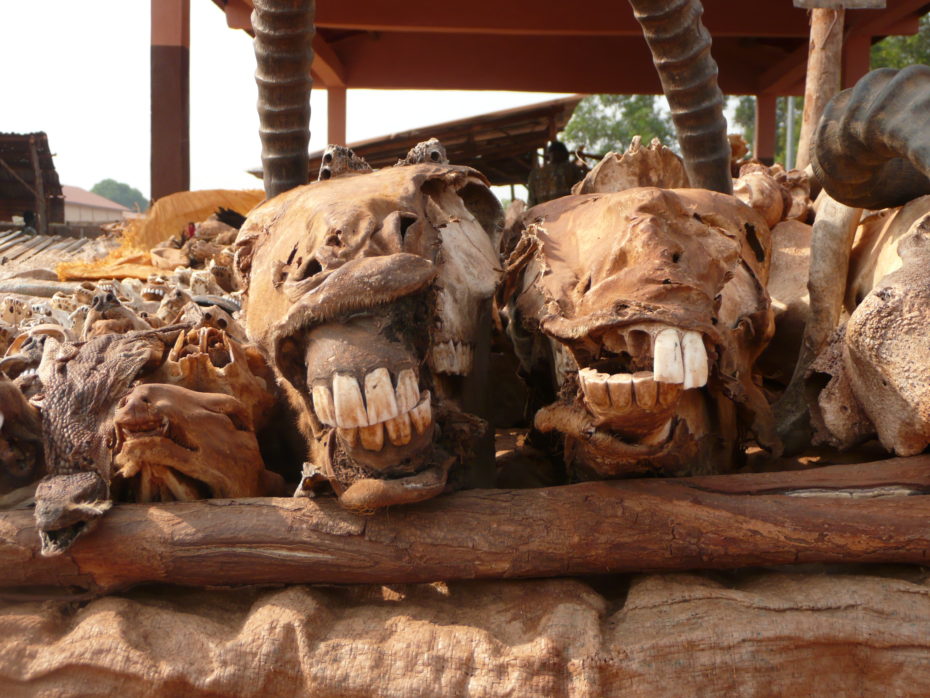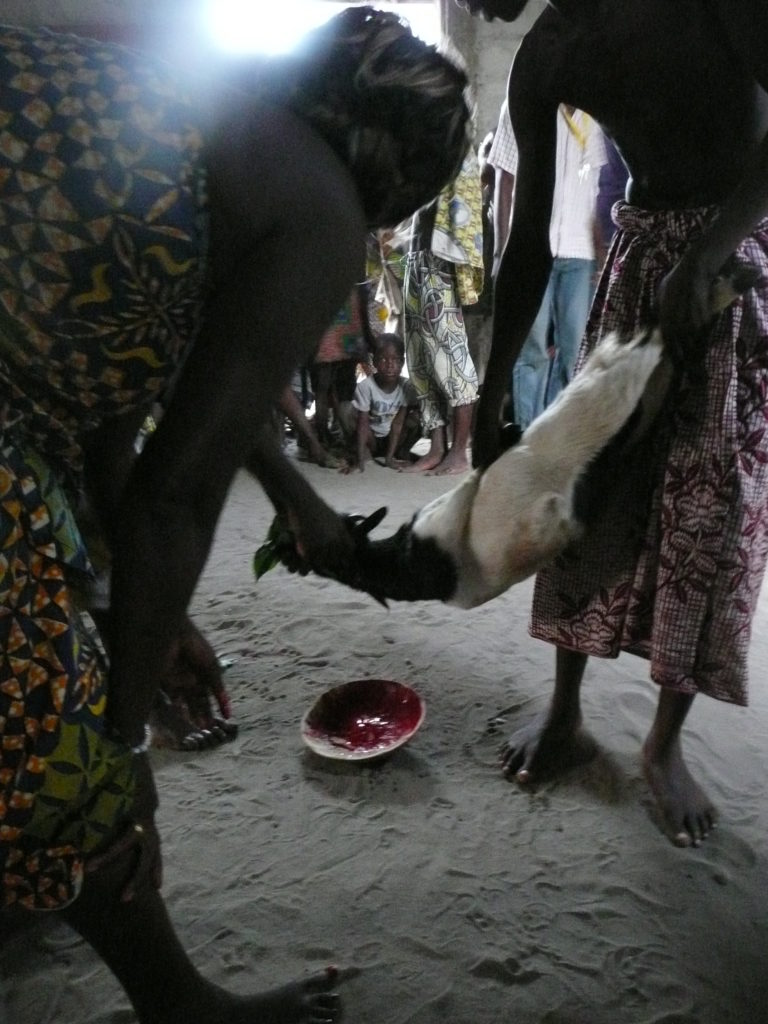The somewhat challenging nature of Voodoo for animal lovers is put to the ultimate test at the fetish markets. These are the pharmacies of the voodoo world: after a consultation the priest will provide a prescription which is then purchased from the market. The stalls look a bit like the trophy collection of some psychotic, random animal hunter: great arrays of heads in varying states of decomposition, dogs, monkeys, cattle, birds and even most definitely endangered creatures such as leopards feature. The smell resembles a recently abandoned abattoir and considering that these items are often ground up and made into potions one can only assume that Voodoo has led to a major evolution in the hardiness of its followers’ digestive systems, any weak stomached individuals surely having been killed off years ago. Heads are not the only tasty morsels on display and the pick of the bunch would have to be a clutch of pig’s wombs, plump with fetuses and providing an edible nirvana for the swarms of flies enticed by the delightful odour.
The main focus of festivities for the Benin’s national holiday of Voodoo day on Jan 10th take place in the coastal town of Ouidah due to its long associations with the religion. Several traditional ceremonies take place in and around Ouidah in the days leading up to the festival celebrating the big day, but as with the festival itself, events are characterised by the African approach to what on other continents would be referred to as organisation, but here is a more organic approach, whereby a lot of stuff will definitely happen, in some form or another, at some points and in some locations, very little of which can be stated with any precision even by local inhabitants. A printed programme of events, including the three days preceding the festival arrived in a limited number on the penultimate evening and whilst not being an entire work of fiction really served no practical purpose. Hence paying a guide is a wise investment but not always a guarantee, as all kinds of people can take advantage of the influx of tourists to earn some much needed money. Frustrated tourists could be seen rushing around with a “guide” making enquiries on his mobile, arriving at a location to find an event which finished three hours ago or not on until tomorrow, possibly. Paying for an official guide can be regarded by some travellers who see themselves above the lowly tourist as a cop out, in this case such people will see little and learn nothing.
With all this in mind I was concerned that the evening’s ceremony in a nearby village which my guide had arranged for me to see may also be a bit of a show. I needn’t have worried for it was very much the real deal, for a start I only had to fork out enough for some offerings of a bottle of gin (alcohol is essential in most ceremonies) and some kola nuts, most of which was sprayed over the fetish shrine in asking the spirits permission for the presence of a stranger, so no one was going to be partying it up big style at my expense. Please note that a fetish in this sense is an object housing the spirit of a being, creature or ancestor and no leather or painful piercings are involved, it is derived from the attempts of early Portuguese travellers in the region to describe what they encountered, an experience beyond their Christian terminology. When I say that it took place in the village temple you should not have any images of ornate grandeur that other religions my require, I have come across cow sheds of greater opulency in Britain. A central chamber houses the modest mound like shapes of the fetish shrines over which offerings are poured, this has an antechamber with two openings where I sit for the initial proceedings with a dozen or so locals and female adepts in front of the priest. Surrounding this structure entirely was another building which allowed the shrine to be perambulated about freely and provided a space for other villagers. Alas I forgot to ask afterwards why we all had to have a bunch of leaves waved in our faces but waving stuff about seems a prerequisite for all religions so I doubt it represented anything too significant such as offering up my soul for eternal torment. In the outer, surrounding space drummers played a series of rhythms, each signifying a different portion of the ceremony, the women chant in time and offerings are made. If you are used to the formalised ritual of English churches the ceremony, as with other events I have witnessed in Africa, seems rather chaotic – people come and go, kids crowd around the door or at our feet. Surprisingly no mobile phone conversations went on, probably a rare coincidence as even church weddings are serenaded by ring tones, although their owners at least have the courtesy to go outside for the conversation.
As soon as I saw, on entering the temple, the cute, kid goat tied up I knew its demise was inevitable and sure enough, it was duly sacrificed, struggling for a minute as its throat was cut to drain the blood into a bowl, a portion of which was poured over the fetishes. A chicken was similarly dispatched and its blood used to glue handfuls of its feathers to pillars and patches of wall – apparently even the walls have eyes and must be placated, as it was explained to me later. The goat carcass is then swung back and forth seven times through the antechamber opening before being flung on the eighth, each move representing a colour of the rainbow, in turn representing the totality of the population of the village requiring protection by the spirits. As the carcass hits the floor a great roar goes up from the assembled masses and the women commence a dance circling the central structure. The women aim to enter into a trance, whereupon the barriers between the visible and invisible worlds are broken for them. Although not on this occasion, the women can attain the kinds of states of spiritual ecstasy you might see at an evangelical service. You will be glad to hear that the goat is not wasted as only its blood is required and it will be eaten later. Some ceremonies do however require that an animal is buried alive, even occasionally something as large as a cow, which does raise some logistical issues that I’ll leave you to dwell upon should you so desire.






